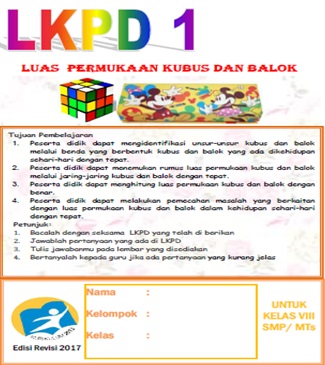
Development of Learning Tools with the Discovery Learning Model to Improve the Critical Thinking Ability of Mathematics
Abstract
Keywords
Full Text:
PDFReferences
Aizikovitsh-Udi, E., & Cheng, D. (2015). Developing Critical Thinking Skills from Dispositions to Abilities: Mathematics Education from Early Childhood to High School. Creative Education, 6 (04), 455.
Akbar, S. (2013). Instrumen Perangkat Pembelajaran. Bandung: PT Remaja.
Amirullah, A. H. (2018). Lesson Study: An Approach to Increase the Competency of Out-of-Field Mathematics Teacher in Building the Students Conceptual Understanding in Learning Mathematics. Journal of Educational Sciences, 2(2), 1-13.
Chukwuyenum, A. N. (2013). Impact of Critical Thinking on Performance in Mathematics among Senior Secondary School Students in Lagos State. IOSR Journal of Research & Method in Education, 3(5), 18-25.
Dewi, N. W. D. P., Suharta, I. G. P., Si, M., & Ardana, I. M. (2014). Pengembangan Perangkat Pembelajaran Matematika dengan Pendekatan Scientific Berorientasi Teknologi Informasi dan Komunikasi untuk Meningkatkan Kemampuan Pemecahan Masalah dan Penalaran Siswa. Jurnal Pendidikan dan Pembelajaran Matematika Indonesia, 3(1).
Facione, P. A. (1990). Critical Thinking: Statement of Expert Consensus Forpurpuses of Educational Assessment and Instruction. The Delphi Report. California: California Academic Press. Eric Doc. No.: ED 315 423.
Ginanjar, A., Seragih, S., & Kartini. (2019). Effectiveness of Learning with Scientific Approach in Cooperative Model of STAD-Based Type Lesson Study. Journal of Educational Sciences, 3(2), 249-259.
Haeruman, L. D., Rahayu, W., & Ambarwati, L. (2017). Pengaruh Model Discovery Learning terhadap Peningkatan Kemampuan Berpikir Kritis Matematis dan Self-Confidence Ditinjau dari Kemampuan Awal Matematis Siswa SMA di Bogor Timur. JPPM (Jurnal Penelitian dan Pembelajaran Matematika), 10(2).
Jaya, I. M., Sadia, I. W., Arnyana, I. B. P., & Si, M. (2014). Pengembangan Perangkat Pembelajaran Biologi Bermuatan Pendidikan Karakter dengan Setting Guided Inquiry untuk Meningkatkan Karakter dan Hasil Belajar Siswa SMP. Jurnal Pendidikan dan Pembelajaran IPA Indonesia, 4(1).
Johnson, E. B. (2009). Contextual Teaching & Learning. Bandung: Penerbit MLC.
Kalelioğlu, F., & Gülbahar, Y. (2014). The Effect of Instructional Techniques on Critical Thinking and Critical Thinking Dispositions in Online Discussion. Journal of Educational Technology & Society, 17(1), 248-258.
Kriel, C. (2013). Creating a Disposition for Critical Thinking in the Mathematics Classroom. In Conference of the South African Society for Engineering Education (p. 67).
Kurniati, I. W., Pujiastuti, E., & Kurniasih, A. W. (2017). Model Pembelajaran Discovery Learning Berbantuan Smart Sticker untuk Meningkatkan Disposisi Matematik dan Kemampuan Berpikir Kritis. Kreano, Jurnal Matematika Kreatif-Inovatif, 8(2), 109-118.
Martaida, T., Bukit, N., & Ginting, E. M. (2017). The Effect of Discovery Learning Model on Student’s Critical Thinking and Cognitive Ability in Junior High School, 7 (6), 1–8.
Rohaumah, C. (2018). Pengaruh Metode Pembelajaran Discovery Learning Terhadap Kemampuan Bepikir Kritis Siswa Dalam Pembelajaran Matematika. Gammath: Jurnal Ilmiah Program Studi Pendidikan Matematika, 3(1).
Roza, Y., Yuanita, P., Saragih, S., Alfajri, H., & Saputra, A. (2017). Computer-Based Media for Learning Geometry at Mathematics Class of Secondary Schools. Journal of Educational Sciences, 1(1), 79-91.
Tanjung, H. S., & Nababan, S. A. (2018). Pengembangan Perangkat Pembelajaran Matematika Berorientasi Model Pembelajaran Berbasis Masalah (PBM) untuk Meningkatkan Kemampuan Berpikir Kritis Siswa SMA Se-Kuala Nagan Raya Aceh. Genta Mulia: Jurnal Ilmiah Pendidikan, 9(2).
Yulius, B., Irwan, I., & Yerizon, Y. (2017). Pengembangan Perangkat Pembelajaran Matematika Berbasis Model Pembelajaran Penemuan dengan Masalah Open Ended untuk Peserta Didik SMA Kelas X Semester 2. Mosharafa: Jurnal Pendidikan Matematika, 6(2), 279-286.
Zarkasyi, Wahyudin. (2015). Penelitian Pendidikan Matematika. Bandung: PT Refika Aditama.
DOI: http://dx.doi.org/10.31258/jes.4.1.p.83-92
Refbacks
- There are currently no refbacks.
Copyright (c) 2020 Anike Putri, Yenita Roza, Maimunah Maimunah

This work is licensed under a Creative Commons Attribution 4.0 International License.
Publisher: FKIP Universitas Riau












